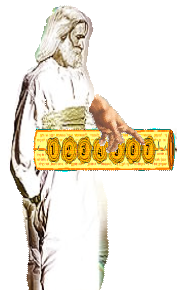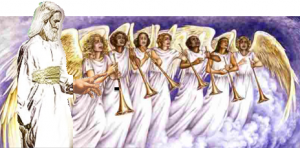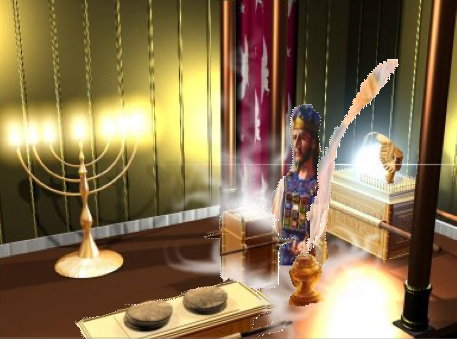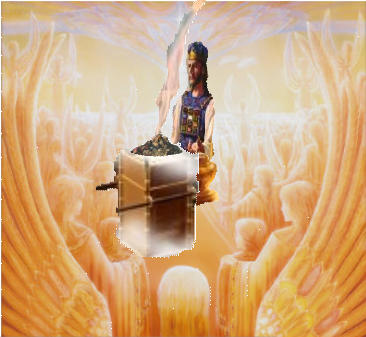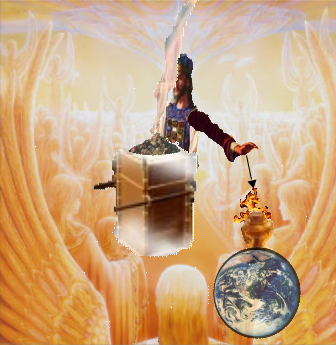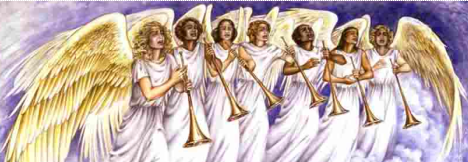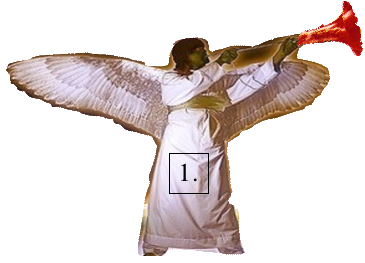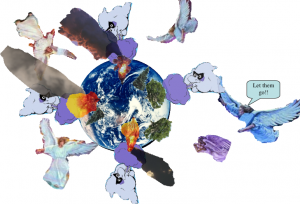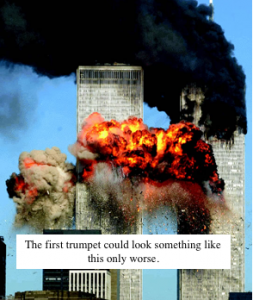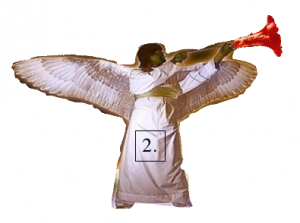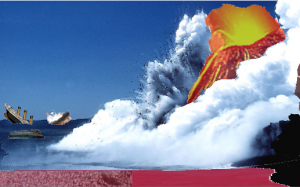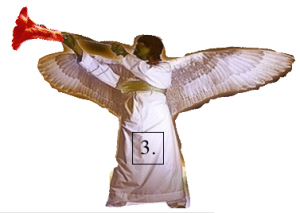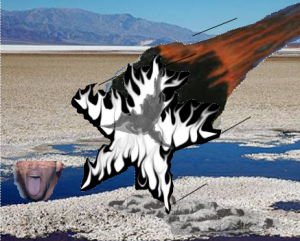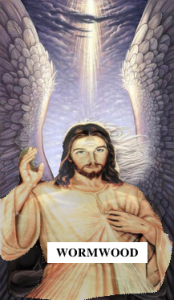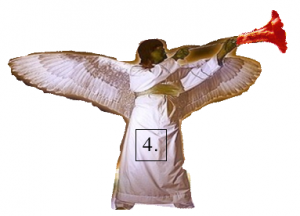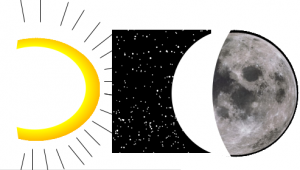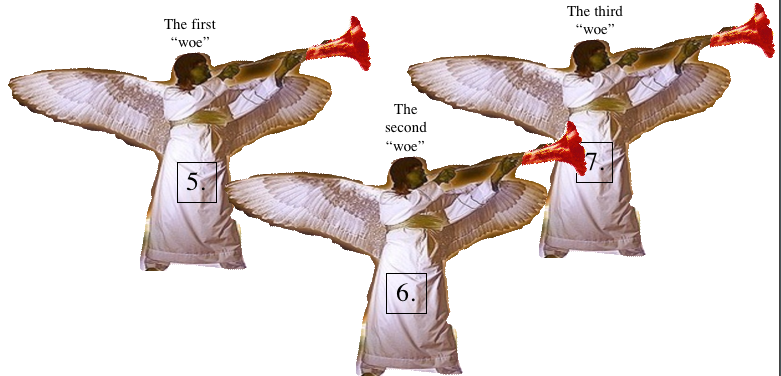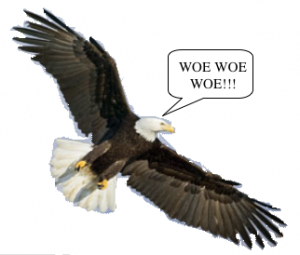This chapter moves us forward from “the sixth seal” scenario (Revelation 6:12-7:17), with the saints enjoying “the Lamb” leading “them unto living fountains of water” in heaven where they will remain forever, to the scenario of “the seventh seal.” Having answered the question “who shall be able to stand?” (Revelation 6:17) in Chapter 7, John now takes us backward [1] in sequence to the last day scenario, prior to the saints’ reward in heaven, and just before the “four winds of the earth” have been released by the four angels. [2] These four angels had been protecting the earth, sea and trees from the destructive effects of the four winds, allowing time for the sealing of the saints with “the seal of the living God” (Revelation 7:1-9).
Verse 1: And when he had opened the seventh seal, there was silence in heaven about the space of half an hour.
We now come to the mysterious “silence in heaven” that lasts for approximately “half an hour” when the “seventh seal” is “opened.” This “silence” is in sharp contrast to the “loud voice” of the “great multitude” crying “Salvation to our God which sitteth upon the throne” (Revelation 7:10). Therefore, this scene, which is also “in heaven,” must precede that noisy demonstration.
Many believe the “silence” is due to heaven being emptied of its inhabitants after they have “left the celestial courts to accompany Christ to the earth” [3], with the “half an hour” assumed to represent “about one literal week” [4] of prophetic (day-for-a-year) time.
Another explanation suggests the “silence in heaven to be a silence of awesome expectation,” and the “half an hour” to be “simply a short period of unspecified length.” [5] However, all three words, “half an hour,” are translated from one Greek word “hemiorion” [6] meaning “half an hour.” Since “hemiorion” is not found anywhere else in the Bible, we are left with no alternative other than to accept a literal translation―approximately thirty minutes. [7] Such a brief period of time is much too short for anything other than a collective “holding of the breath” by all the heavenly onlookers; for, they are closely watching the successive events taking place on earth during the end-time scenario of the last seal.
Therefore, the inhabitants of heaven (identified as the “watchers” in Daniel 4:17) are still in heaven making this “silence” much more likely to be “a silence of awesome expectation.” Expectation of what? Even though humans may be largely unaware, even uncaring, the angels are very aware of what is about to happen. It will be something that has never transpired since sin entered the world.
The Commentary refers to two instances in which White mentions “silence.” [8] In one reference there is “silence” on earth at the time of the second coming, but not in heaven. The other reference is a time of “silence in heaven [when] no harp was touched [and] in silent grief [the angels] watched the Father separating His beams of light, love and glory from His beloved son . . .” when He was in the garden of Gethsemane two thousand years ago. Neither of those references fulfill all the specifications of this thirty-minute period of silence in heaven, although the last comes closer.
This silence comes when the “seventh seal” is opened, and after the 144,000 and the “great multitude” have been “sealed “in their foreheads,” after the “sixth seal” was opened. Explaining this to be “a silence of awesome expectation” is harmonious with the context and makes good sense. Therefore, instead of concluding “ . . . all the heavenly harpers leave the courts above to come to this earth. . .” [9] during that half hour, it will be a brief moment before the scene in which “all the angels stood round about the throne, and about the elders and the four beasts, and fell before the throne on their faces, and worshipped God, Saying, Amen: Blessing, and glory, and wisdom, and thanksgiving, and honour, and power, and might, be unto our God for ever and ever” (Revelation 7:11, 12) celebrating the victory of the “great multitude” as they “cried . . . Salvation to our God . . . and unto the Lamb” (Revelation 7:10).
That anthem of praise cannot have taken place before the sealed multitude is required “to stand in the sight of a holy God without a mediator.” [10] Only if they really do continue to “stand” after that, will the angels have something to sing about. Consequently, during this brief moment of time when the question of Revelation 6:17, “who shall be able to stand?” is about to be answered, “no harp [will be] touched” as the angels watch what is about to happen. [11]
Verse 2: And I saw the seven angels which stood before God; and to them were given seven trumpets.
It will be easy to get confused later on if it is not recognized that there are two “seven angels” groups in the book of Revelation. These seven trumpet-bearing angels are not the same as the “seven angels” who have “the seven last plagues” to whom were given “seven golden vials [not trumpets] full of the wrath of God . . .” (Revelation 15:1, 6, 7. 8; 16:1; 17:1 and 21:9).
Also, as this picture shows, these “seven [trumpet bearing] angels” do not sound their instruments right away. They not only wait for Jesus to do something else before they begin to blow, but also sound them sequentially, one after the other rather than simultaneously. Consider also, that this sounding takes place after the seventh seal is opened, because there is no evidence, whatsoever, that they recapitulate the scenarios of the preceding seals or even the seven churches. Later on, we will discover that the “seven” vial bearing angels will not begin to “pour” out their “vials” until after the “seventh” trumpet bearing angel has sounded.
Verse 3: And another angel came and stood at the altar, having a golden censer; and there was given unto him much incense, that he should offer it with the prayers of all saints upon the golden altar which was before the throne.
As the Commentary notes, this “is, not one of the seven angels with the trumpets.” And, because “The scene portrayed may be understood as symbolic of the ministration of Christ for His people” [12], it is clear this “angel” is Christ Himself. [13]
He “came and stood at the altar.” The last time He “came,” was when He had left the holy place in the heavenly sanctuary to take “the book out of the right hand of him that sat upon the throne” (Revelation 5:7) in the most holy place. Now, it appears He has left the most holy place to stand in front of the “altar” of incense in the holy place! (Exodus 30:1, 6).
The apostle Paul’s description of the earthly sanctuary is helpful. Note that “after the second veil . . . called the Holiest of all” is found “the golden censer, [14] and the ark of the covenant . . .” He doesn’t say just where the censer was in relation to the ark, but we can assume it was placed, by the high priest, on top of the ark between the “cherubims of glory [15] shadowing the mercyseat . . .” (Hebrews 9:3-5) in the second apartment.
Now, Jesus has picked up the “golden censer,” that He must have carried with Him into the most holy place (Revelation 5:7) and carries it with Him back into the holy place and stands “at the . . . golden altar which was before the throne” represented by the “table of shewbread” (Hebrews 9:2, Exodus 25:23, 30).
Notice that the “incense” is mingled with “the prayers of all saints,” without which their prayers would be useless. Note also that Jesus places the “incense . . . upon the golden altar,” not in the “golden censer,” an extremely important item to remember as we continue studying this breathtaking scenario.
Verse 4: And the smoke of the incense, which came with the prayers of the saints, ascended up before God out of the angel’s hand.
“The incense, ascending with the prayers of Israel, represents the merits and intercession of Christ, His perfect righteousness, which through faith is imputed to His people, and which can alone make the worship of sinful beings acceptable to God. Before the veil of the most holy place, was an altar of perpetual intercession, before the holy, an altar of continual atonement. By blood and by incense, God was to be approached, —symbols pointing to the great Mediator, through whom sinners may approach Jehovah, and through whom alone mercy and salvation can be granted to the repentant, believing soul.” [16]
Even now, Jesus is “. . . our Advocate offering up the incense of His own merits in our behalf. When we see this as it is, and as the Lord would have us, we shall be filled with a sense of the immensity and diversity of the love of God.” [17]
According to Verse 3, the “incense” was offered “with the prayers of all saints upon the golden altar.” Here we see “the smoke of the incense” ascending “up . . . out of the angel’s hand,” which seems odd. Since the incense is placed on the “altar” (Verse 3), it would seem the “smoke” ascends from the incense on the “altar” instead of the angel’s “hand.” A possible solution could be found in the Greek word for “out of” which is “ek” or “ex.” [18] It could be translated “away from,” or “by.” If “by” is allowed, it could be understood as: “the smoke ascended up from the altar” by the hand of, or through the instrumentality of the angel. Therefore, we can conclude that the “smoke of the incense” came up from the incense on the “altar” where Jesus placed it as stated in Verse 3.
This picture might be helpful in understanding that important point. It is important, not only because it gives us the proper perspective for understanding what takes place in the next verse, but because the incense, being representative of God’s sustaining grace, is full of comfort and assurance for the saints as they face the prospect of a time of trouble during which there will be no mediator in the heavenly sanctuary.
Verse 5: And the angel took the censer, and filled it with fire of the altar, and cast it into the earth: and there were voices, and thunderings, and lightnings, and an earthquake.
In Verse 3, He had the “golden censer.” Here He takes it. Knowing that the sequence of events and actions do not always follow exactly like the western mind perceives, it is possible He “took the censer” from the most holy place before He “came and stood at the altar” in the holy place. On the other hand, He may have set it down while taking the incense out of it in order to place it “upon the golden altar.” He took “the censer, and filled it” entirely [19] “with the fire of the altar.” In other words, He fills his censer with coals of fire, “but adds no incense.” [20]
That the “incense” and the “fire” are not one-and-the-same, can be understood when “Moses said unto Aaron, Take a censer, and put fire therein from off the altar, and put on incense, and go quickly unto the congregation, and make an atonement for them . . . and Aaron took as Moses commanded . . . and he put on incense, and made an atonement for the people” (Numbers 16:46, 47). That also makes clear that the “incense” represents the blood of the “atonement.”
Consequently, this “incense” represents the mercy of God. The “fire,” on the other hand, symbolizes His justice.
Therefore, when that angel cast the censer “into the earth,” the absence of incense in the censer signifies the absence of mercy! “The meaning of this act is significant for the understanding of what follows as the trumpets are blown . . . According to the view that Seventh-day Adventists have favored, the cessation of the Angel’s ministry at the altar of incense is symbolic of the end of the ministration of Christ for mankind—the close of probation.” [21]
White, in vision, “. . . saw angels hurrying to and fro in heaven. An angel returned from the earth with a writer’s ink-horn by his side, and reported to Jesus that his work was done, that the saints were numbered and sealed. Then I saw Jesus, who had been ministering before the ark containing the ten commandments, throw down the censer. He raised his hands upward, and with a loud voice said, It is done. And all the angelic host laid off their crowns as Jesus made the solemn declaration, He that is unjust, let him be unjust still; and he which is filthy, let him be filthy still; and he that is righteous, let him be righteous still; and he that is holy, let him be holy still.” [22]
Consequently, Revelation 8:5 marks the end of the Investigative Judgment that began when the “Lamb . . . came and took the book out of the right hand of him that sat upon the throne” (Revelation 5:7), also when “Michael stand[s] up” Daniel 12:1). Now begins the premillennial, post probationary executive judgment. [23]
But remember, “the smoke of the incense, which came with the prayers of the saints,” is still ascending “up before God” from “the golden altar” where the incense was originally placed (Verse 3). That should bring great encouragement as we face the future. Without His sustaining grace, the saints could not stand for one moment, let alone the “half an hour” of Verse 1!
Verse 6: And the seven angels which had the seven trumpets prepared themselves to sound.
These are the same “seven angels which stood before God” (Verse 2). They had just received their “seven trumpets,” evidently from Jesus Himself, but held them quietly waiting for Jesus to cast the censer “into the earth” signifying that probationary time had ceased, as we saw in Verse 5. Now the moment of time for their sounding has come. [24]
Therefore, a close unbreakable linkage is seen between the brief “silence in heaven” (Verse 1), the seven angels’ reception of their trumpets (Verse 2), but maintaining their silence while Jesus leaves the most holy place (Verse 3), takes the incense out of the censer and places it on the altar, fills the censer with fire, and casts it “into the earth;” and only then do the “seven angels” make preparation to sound their trumpets.
While many rightly hold that “in the message to the “seven churches, Jesus unfolds the religious history of the Christian era,” it is clear that the seven trumpets do not depict “the military history of the Christian era as it affects Christ’s church” [25], which many believe. Such understanding, although long held, is unsupportable because it separates the trumpets (Verses 2, 6) from their natural setting (Verses 3-5), portraying Jesus coming out of the most holy place and entering the holy place of the heavenly sanctuary to conclude His ministry in the heavenly sanctuary.
Note again, even though these seven angels receive their trumpets (Verse 2), they are not sounded until Jesus completes the activity described in Verses 3 to 5. The traditional belief runs counter to the clear evidence that the trumpets succeed the close of probation. They cannot be pushed back into history without doing violence to these passages. May God help us to see the importance of this and be willing to abandon anything that cannot be supported by scripture.
Verse 7: The first angel sounded, and there followed hail and fire mingled with blood, and they were cast upon the earth: and the third part of trees was burnt up, and all green grass was burnt up.
Clearly, it is the piercing sound of this first trumpet that shatters the “silence” (Verse 1), while the praise service in heaven (Revelation 7:11, 12) probably takes place a little later, although we are not told when.
According to the Commentary (looking at this trumpet from the historic perspective which considers it to be parallel to the first church of Chapter 2), what is shown here is “descriptive of the invasion of the Roman Empire by the Visigoths under Alaric” that took place “in A.D. 410” [26], which is long after the first period of the Christian era, generally recognized to end about the year 100 A.D. [27] Therefore, even from the historic perspective, the dates don’t coincide.
Refer back to the first verses of Chapter 7 where “four angels” are seen “standing on the four corners of the earth” protecting “the earth . . . sea” and “trees” until God’s “servants” have been sealed in their foreheads.” [28] Here, “the earth” and the “trees” are “hurt” suggesting not only that “the four winds” have been released, but that “the servants of our God” have been “sealed in their foreheads,” making it impossible to prove from scripture that the trumpet scenarios belong to history.
Since the “four winds” represent “the terrible power of Satan,” [29] their release represents the fact that Satan is responsible for the “hail, fire, blood” and the fires that burn up “the third part of [the] trees and “all green grass.”
Therefore, the destruction, at this time, does not come directly from the hand of God. He only permits it. Neither is the trumpet sound [30] a command to Satan, rather it is a warning to us (right now) of what to expect after the close of probation. “The only safeguard against his [Satan’s] power is found in the presence of Jesus. Before men and angels, Satan has been revealed as man’s enemy and destroyer; Christ, as man’s friend and deliverer.” [31]
That Satan is directly involved in the trumpet events, is a new thought to most of us. But White refers to Satan’s unbridled control of humanity, immediately after the close of probation, in several statements which coincide with John’s sequencing of the trumpets that sound immediately after the angel casts the censer “into the earth” (Revelation 8:5). That should convince us that the trumpet scenario is the time when “Satan [will have] entire control of the finally impenitent.” [32]
The first trumpet event may have been portrayed to White when in vision. She says: “It seemed that an immense ball of fire came down upon the world, and crushed large houses. From place to place rose the cry, ‘The Lord has come! The Lord has come!’ Many were unprepared to meet Him, but a few were saying, ‘Praise the Lord!’
“‘Why are you praising the Lord?’ inquired those upon whom was coming sudden destruction.
“‘Because we now see what we have been looking for.’
“‘If you believed that these things were coming, why did you not tell us?’ was the terrible response. ‘We did not know about these things. Why did you leave us in ignorance? Again and again you have seen us; why did you not become acquainted with us, and tell us of the judgment to come, and that we must serve God, lest we perish? Now we are lost!’” [33]
The “sudden destruction” that “was coming” to the inquirers and the belief that they “are lost” suggests this to be a post probationary scenario. Also, that the “ball of fire [that] crushed large houses” is more likely descriptive of present-day warfare than the ancient weaponry used for the destruction of Rome, the timeframe traditionally given to the first trumpet. Additionally, the bitter complaint against those who were expecting those things, and who could have warned them about the prospect of that fiery ordeal, should give us cause for serious concern. Evidently, those who were “praising the Lord” understood the future application of the trumpet scenario. They are not condemned for misapplying the trumpets, but for neglecting to share their understanding of future events.
Quite likely, smoke from the smoldering ruin of tree and grass (as well as buildings), will hang heavily in the air for some time. The wording of Verse 7 makes it appear that a “third” of all the trees and all “green grass” over the entire world, will be subjected, not only to “hail,” but “fire.” Therefore, a suffocating pillar of smoke could blanket the globe, producing, perhaps, an inverted greenhouse effect that would cool the earth’s climate, which could account for the associated “hail.”
Verses 8, 9: And the second angel sounded, and as it were a great mountain burning with fire was cast into the sea: and the third part of the sea became blood; And the third part of the creatures which were in the sea, and had life, died; and the third part of the ships were destroyed.
The “second” trumpet is not “sounded” until the “hail” and “fire” of the “first” trumpet warn of the coming destruction of the “earth, trees” and “grass.” Nevertheless, there must be some overlap between these awful catastrophes, because “. . . the final movements will be rapid ones,” [34] including the time when “Trumpet after trumpet is to be sounded . . . one after another upon the inhabitants of the earth.” [35]
Here, John saw “as it were [36] a great mountain . . .” suggesting the “mountain” to be figurative, not literal. Although the Commentary declares this to be metaphoric of the Vandal’s invasion of Rome in A.D. 455, it also draws attention to “Jeremiah 51:25, where the prophet describes Babylon as a ‘destroying mountain’ that will be made a ‘burnt mountain.’” [37] In that case, this “mountain” is a metaphor for “Babylon,” not an erupting volcano.
Ancient Babylon was not destroyed by fire, neither was it “cast into the sea.” In fact, many archeological artifacts of that city remain intact to this day. [38] But, mystical Babylon, that the angel of Revelation 14:8 declares to be “fallen,” is a metaphor for all the fallen churches of the world. Its doom will come during the postmillennial time of “fire and brimstone” (Revelation 14:8-11; 20:9, 10, 14, 15), while the second trumpet is a premillennial catastrophe.
There is a premillennial fiery disaster spoken of in Daniel 7:11, 12 which comes to “the horn” power after it became “the beast.” Daniel says: “I beheld . . . his body destroyed, and given to the burning flame.” That conflagration is clearly premillennial because the “lives” of “the rest of the beasts” “were prolonged for a season and time” after the preceding beast was destroyed by “fire,” whereas all are destroyed in the postmillennial lake of fire (Revelation 20:14, 15).
A premillennial “fire” is also spoken of in Revelation 19:20, 21 where “the beast was taken, and . . . cast alive into a lake of fire burning with brimstone, and the remnant were slain with the sword . . .” without being burned. That “beast” is represented in Revelation 17 as a corrupt woman whose name was “BABYLON THE GREAT.” She is hated by “ten kings” that “make her desolate, and naked, and shall eat her flesh, and burn her with fire” (Revelation 17:3, 5, 12, 16). Those who are not burned in that fire, “stand afar off” lamenting for “the smoke of her burning” (Revelation 18:9, 10, 15, 17, 18).
Therefore, on the basis of this evidence, we can at least conclude this “great mountain burning with fire,” to be representative of “BABYLON THE GREAT” who will come to her doom during the post probationary, premillennial time of the second trumpet.
But there is still more to understand. That cataclysm contaminates the “sea” to such an extent that “the third part of the sea became blood; and the third part of the creatures which were in the sea . . . died; and the third part [39] of the ships were destroyed”! That must account for the bitter grief expressed by “every shipmaster, and all the company in ships, and sailors, and as many as trade by sea [who] stood afar off, and cried when they saw the smoke of her burning . . .” (Revelation 18:17, 18).
Verses 10, 11: And the third angel sounded, and there fell a great star from heaven, burning as it were a lamp, and it fell upon the third part of the rivers, and upon the fountains of waters; And the name of the star is called Wormwood: and the third part of the waters became wormwood; and many men died of the waters, because they were made bitter.
As much as we would like to agree with the Commentary that suggests this to be a portrayal of “the invasion and ravages of the Huns under the leadership of their king Attila . . . about A.D. 372,” [40] it should now be clear to us that it is scripturally impossible to consistently post this event to history, as generally believed.
Remember, none of the trumpets are sounded until “the servants of our God” had been “sealed . . . in their foreheads” before the “four winds of the earth” had been released and “the angel took the censer . . . filled it with fire . . . and cast it into the earth” (Revelation 7:2, 3; 8:5).
We can be certain this is the case because, by this time, “the earth, sea and trees” will have been terribly “hurt” by the “hail and fire mingled with blood” and the “great mountain burning with fire” will have been “cast into the sea,” a third of which “became blood.” As bad as things have been on the earth in recent history, no event has even come close to the horrendous devastation caused by the first two trumpet scenarios.
Likewise, anyone who thinks he/she, or anyone else, is one of the 144,000 sealed saints is under serious delusion. Don’t forget: “the image of the beast . . . is the test the people of God must have before they are sealed.” [41] The “image test” [42] has not yet happened, although it should be clear to anyone familiar with prophecy that it is coming soon.
If this trumpet is also descriptive of a future event, what is the nature of this “great star” that “fell . . . from heaven?” With a “third part” being a portion of this scenario as in the first and second trumpets, we have reason to believe it to be another demonstration of Satan’s demonic power. Some, dissatisfied with the historic viewpoint, have interpreted the “star” to be something inanimate, such as a meteor. But the destruction caused by a meteor of sufficient size to affect a “third part of the rivers” and “fountains of waters” would be far more devastating than merely causing water to become bitter.
Note that the “star” is given a proper name: “Wormwood,” suggesting it to be animate. There are some instances in the Bible where “persons” or images are called a “star.” Christ Himself is depicted as “a Star out of Jacob,” and “the bright and morning star (Numbers 24:17; Revelation 22:16).
“Moloch, Chiun” and “Remphan” are names given heathen images and called “the star of your god” (Amos 5:26; Acts 7:43). The name “Lucifer” is from a Hebrew word meaning “light-bearer, shining one,” or: “morning star.” [43]
Basically, then, we are left with two options: this “star” represents Christ, or Satan. Since it “fell from heaven” and involves “the third part of the rivers, and . . . the fountains . . .” the choice seems clear: it represents Satan. Maxwell, even though viewing it from the historic perspective, suggests the star represents “Satan, the fallen Wormwood angel.” [44]
Why would Satan be named “Wormwood?” [45] The Commentary suggests it to be the name of “a notoriously bitter herb, Artemisia absinthium.” [46] It is not difficult to associate its bitterness with the experience of anyone who falls for Satan’s lies. Since this is a post probationary, premillennial event, his coming down “from heaven, burning as it were a lamp,” suggests some kind of spectacular, mind-boggling deception practiced on the world that he has never before been allowed to perform.
Jesus warns us “there shall arise false Christs, and false prophets, and shall shew great signs and wonders; insomuch that, if it were possible, they shall deceive the very elect” (Matthew 24:24), remarking on another occasion that He “beheld Satan as lightning fall from heaven.” (Luke 10:18). Paul says: “no marvel; for Satan himself is transformed into an angel of light” (2 Corinthians 11:14). Although Paul died long before John was given his vision, it would have been a natural for him to conclude Wormwood to be representative of the satanic “angel of light.”
“As the crowning act in the great drama of deception, Satan himself will personate Christ. The church has long professed to look to the Saviour’s advent as the consummation of her hopes. Now the great deceiver will make it appear that Christ has come. In different parts of the earth, Satan will manifest himself among men as a majestic being of dazzling brightness, resembling the description of the Son of God given by John in the Revelation (Revelation 1:13-15). The glory that surrounds him is unsurpassed by anything that mortal eyes have yet beheld. The shout of triumph rings out upon the air, ‘Christ has come! Christ has come!’ The people prostrate themselves in adoration before him, while he lifts up his hands, and pronounces a blessing upon them, as Christ blessed his disciples when he was upon the earth. His voice is soft and subdued, yet full of melody. In gentle, compassionate tones he presents some of the same gracious, heavenly truths which the Saviour uttered; he heals the diseases of the people, and then, in his assumed character of Christ, he claims to have changed the Sabbath to Sunday, and commands all to hallow the day which he has blessed. He declares that those who persist in keeping holy the seventh day are blaspheming his name by refusing to listen to his angels sent to them with light and truth. This is the strong, almost overmastering delusion. Like the Samaritans who were deceived by Simon Magus, the multitudes, from the least to the greatest, give heed to these sorceries, saying, This is ‘the great power of God.’” [47]
Although White says nothing specifically about “Wormwood,” she does say “The great mass of professing Christians will meet with bitter disappointment in the day of God.” [48] The mistaken assumption that a person named “Wormwood” is Christ, when he is actually the Devil, would certainly result in “bitter disappointment.”
Some say that Satan’s personation of Christ must come before the close of probation, not afterwards. After all, what would Satan have to gain after the saints have been sealed? That conclusion is only an assumption, with no support from scripture or White’s writings. Furthermore, it could even be a dangerous assumption. Consider that the chapter title in the book The Great Controversy, from which the above statement was selected is: “The Time of Trouble.” As we read from pages 613 to 624, it becomes readily apparent that White is writing of the post probationary time of Jacob’s trouble. Note, she begins the chapter by quoting Daniel 12:1 when “Michael [shall] stand up” signifying the close of probation.
What would Satan have to gain after the saints have been sealed? Most of us are familiar with this statement: “Just as soon as the people of God are sealed in their foreheads―it is not any seal or mark that can be seen, but a settling into the truth, both intellectually and spiritually, so they cannot be moved . . .” [49] Such a condition could not be expected to discourage Satan’s effort to cause their fall. Consider the fact that, even after reflecting on his past for a “thousand years,” he will still “go out to deceive the nations” once more (Revelation 20:2, 8). During premillennial time, after the close of probation, he would have much more to gain if he could be successful in causing the fall of even one of the saints that had been sealed with “the seal of the living God.” He would become the winner in the great controversy between himself and Christ and all would be lost!
We can be certain that Satan will not relax his efforts in the least, even after the close of probation. In fact, Satan, if he really knew that probation was closed, would be expected to redouble his efforts to cause the saints to fall. Even though martyrdom will no longer take place after the close of probation, [50] Satan will be intensely busy putting as much pressure on the saints as he did against Jesus while He walked upon earth. Satan has much more to gain after the close of probation, than before!
What about the “waters” that “were made bitter?” Later on, an angel tells John that “the waters which thou sawest, where the whore sitteth, are peoples, and multitudes, and nations, and tongues” (Revelation 17:15, italics supplied). Since “many men died of the waters, because they were made bitter” suggests they are not only toxic, but had been ingested, and in that case the “waters” seem to be literal. Another possibility is that the “waters” are figurative of Wormwood’s doctrine or philosophy which brings death to those who “drink” (figuratively).
But whatever the “waters” are: “The great mass of professing Christians will meet with bitter disappointment in the day of God. They have not upon their foreheads the seal of the living God. Lukewarm and halfhearted, they dishonor God far more than the avowed unbeliever. They grope in darkness, when they might be walking in the noonday light of the Word, under the guidance of One who never errs . . .” [51] That “One” is the real author of the book of Revelation that would have spared them their “bitter disappointment.”
Verse 12: And the fourth angel sounded, and the third part of the sun was smitten, and the third part of the moon, and the third part of the stars; so as the third part of them was darkened, and the day shone not for a third part of it, and the night likewise.
Although these trumpets are sounded sequentially, their effects are probably cumulative with the smoke of the first trumpet hanging in the air; then a third of the sea being bloody, a third of the ships sunk to the bottom, from the second trumpet; then Satan disguised as Christ, claiming the loyalty of his deluded followers throughout the earth, in the third.
This trumpet only adds to the confusion of a “time of trouble such as never was since there was a nation, even to that same time.” But God’s people “shall be delivered, every one that shall be found written in the book” of life (Daniel 12:1).
The Commentary, looking at these things from the historical perspective, suggests the “sun, moon, and stars” might be “interpreted to represent the great luminaries of the Western Roman government—its emperors, senators, and consuls” and “the extinction of Western Rome” in A.D. 476. [52] However, Verses 2 to 6 remind us that the trumpets do not sound until Jesus casts the “censer . . . into the earth” (Revelation 8:5), signifying the close of probation. Therefore, the “fourth angel” had not yet sounded, because Jesus had not yet thrown down the censer. We also need to remind ourselves that the note sounded by this trumpet (as well as the previous three) warns of another element in Satan’s last day strategy to marshal the whole world under his command and ultimately, the total annihilation of God’s people.
Furthermore, the dissimilarity between this (fourth) trumpet and the “fourth” plague is striking. When “the fourth (plague) angel poured out his vial upon the sun . . . power was given unto him to scorch men with fire. And men were scorched with great heat . . .” (Revelation 16:8,9). Instead, this fourth trumpet diminishes or darkens, not only a “third part of the sun . . . moon . . . stars, but “a third part” of “the night likewise!” more evidence that the trumpets and plagues are separate and distinct events.
What then, is the significance of the “third part of the sun . . . moon . . . stars” being “smitten” or “darkened” as well as the “day” and even the “night?” While the Commentary places these events in history, the Bible demands a future, end time explanation in terms of another Satanic delusion. Satan causes these fearful sights of a supernatural character, that cannot be explained scientifically, as further proof of his power as Christ, and reinforces belief in him by professing Christians (represented by the red horse of Revelation 6:4). However, the avowed unbelievers, represented by the “pale horse” of Revelation 6:8, who want nothing to do with Christ, will probably consider “Wormwood” a fraud.
Satan is not at all frustrated with the confusion of his followers. He will disguise himself in the form of another supernatural being named “Abaddon” or “Apollyon” the “destroyer” [53], the alternative to Wormwood. In that manner “The spirits of devils will go forth to the kings of the earth and to the whole world, to fasten them in deception, and urge them on to unite with Satan in his last struggle against the government of Heaven. By these agencies, rulers and subjects will be alike deceived.” [54] This deception will attract the “pale horse” people.
By providing leaders for both false believers (red horse people), and avowed unbelievers (pale horse people) Satan can marshal the whole world under his disguises as either Wormwood or Abaddon. This sets the stage for the great conflict, first mentioned by Daniel, when “the king of the south [shall] push at [the king of the north] and the king of the north shall come against him like a whirlwind . . .” (Daniel 11:40). In other words, Satan will engineer a pitched battle between the followers of Abaddon (king of the south) and the followers of Wormwood (king of the north) ―his own followers fighting against each other.
Verse 13: And I beheld, and heard an angel flying through the midst of heaven, saying with a loud voice, Woe, woe, woe, to the inhabiters of the earth by reason of the other voices of the trumpet of the three angels, which are yet to sound!
According to the Commentary: “Textual evidence favors the reading ‘an eagle’” instead of “an angel,” adding “The eagle may be thought of as an omen of
doom.” [55] Regardless, its “loud voice” suggests the warning was given while there was still hope, prior to the time when Jesus cast the “censer . . . into the earth.” While the events foretold by the warnings of the seven angels with the seven trumpets will occur after probation closes, we can learn about them now, while there is still time to prepare. The warning is emphasized: “Woe, woe, woe” [56] suggesting three different cataclysmic events that will bring utter disaster― “One woe is past; and, behold, there come two woes more hereafter” (Revelation 9:12) ―the “second woe is past; and, behold, the third woe cometh quickly” (Revelation 11:14). It is also clear that these woes are the final trumpet events with the first woe being the fifth trumpet, the second woe being the sixth trumpet and the third woe being the seventh trumpet. Smith says the same thing about “the three remaining trumpets” [57]. Keep this important point in mind because it will answer a lot of questions that will arise later on.
Summary of Chapter 8: This chapter commences with the opening of the “seventh seal” and a brief moment of “silence in heaven.” Instead of disconnecting those features from the remainder of the chapter, as many commentators suggest, they are really introductory to what follows. During the moment of “silence,” Jesus leaves the most holy place in the heavenly sanctuary, takes the incense out of the censer, places it on the golden altar (representing his sustaining grace on behalf of the saints during post probationary time), fills the censer with fire of the altar and casts it into the earth, signaling the close of his priestly ministry. The seven angels, who were given seven trumpets during the moment of silence, then proceed to sound them one after another, with the events of the first four trumpets being depicted in this chapter. The earth, sea and trees, that were being protected by the four angels holding the four winds (Chapter 7), are seen to be “hurt” in the first trumpet scenario. Since the terrible power of Satan is represented by those “four winds,” it seems clear that the “hurt” befalling the earth, sea and trees by the first trumpet, indicates that the “four winds” have been released, and “the servants of our God” will have been “sealed . . . in their foreheads.” This is powerful evidence that the trumpets, including the three woes, represent future events.
________________________________________________________________
[1] It is difficult for the western mind to follow John’s sequence in the sixth seal scenario. Seeing that the “sixth seal” (Revelation 6:12) covers the darkening of the sun and falling of stars (Verses 12, 13), then jumps forward to the second coming (Verses 14-17), then back to the sealing (Revelation 7:4-10), then forward again to the reward of the saints (Verses 15 to 17) is confusing. If we are willing to recognize that the question in Revelation 6:17 “who shall be able to stand?” is the focus of the entire “sixth seal” scenario (Revelation 6:12-7:17), we should be able to see that John has answered that question very well with his own style of writing. Now, in Chapter 8, he takes us back again to the opening of the seventh and last seal that he saw on “the book” (Revelation 5:1) that was “sealed with seven seals.” Be prepared to follow what John is saying and expect that he will do some more sequential “jumping” forward and backward in the remaining, wonderful scenarios of the book of Revelation.
[2] Some believe, because of this juxta positioning, that the seventh seal takes place even after the second coming!
[3] see Seventh-day Adventist Bible Commentary, Vol. 7, page 787 (left column under “Silence in heaven.”)
[4] Ibid under “Half an hour.”
[5] Ibid
[6] “half an hour” from “hemiorion” (Strong’s #2256) “hemiorion hay-mee-o’-ree-on from the base of 2255 and 5610; n n. KJV – half an hour 1; 1, 1) half an hour.” This is the only time this word is used in the Bible, and it appears it should be considered to be literal time like “less than thirty minutes.”
[7] See discussion about “time” in Revelation 10:6.
[8] see the comments in Seventh-day Adventist Bible Commentary, Vol. 7, page 787 (left column under “Silence in heaven.) where references to the silence are found in Early Writings by E.G. White, pages 15 & 16; and Desire of Ages by E.G. White, page 693.
[9] see Daniel and the Revelation by Uriah Smith, page 473
[10] The Great Controversy by E.G. White, page 425
[11] Consider this statement from Manuscript Releases by E.G. White, Vol. 15, page 219 (underlining supplied): “Thy right hand, O God, shall dash in pieces Thine enemies. Revelation 6 and 7 are full of meaning. Terrible are the judgments of God revealed. The seven angels stood before God to receive their commission. To them were given seven trumpets. The Lord was going forth to punish the inhabitants of the earth for their iniquity, and the earth was to disclose her blood and no more cover her slain. Give the description in chapter 6.” Note the underlined portion which quotes Revelation 8:2 with the context clearly moving it into the future. If the reader will take the time to look up the quote, they will find that both the succeeding and preceding paragraphs speak of the seven last plague scenario which is also future.
[12] Seventh-day Adventist Bible Commentary, Vol. 7, page 787 (right column under “3. Another angel.” And “With the prayers.”)
[13] Mervyn Maxwell in “God Cares” Vol. 2 pages 228 & 229 says “the angel at the altar in [this] passage . . . seems not to be Jesus. Rather, he seems to be the angel of the altar and fire who is mentioned again in Revelation 14:18.” The view of the Commentary that this angel is Christ is more fitting with the context.
[14] Although a “censer” is depicted in Leviticus 10:1; 16:12; Numbers 16:17, 18, 46; 2 Chronicles 26:19 and Ezekiel 8:11, other than Hebrews 9:4, this is the only place in the Bible that mentions a golden censer. Uncertainty exists over whether it is “a censer or the altar of incense.” (See the discussion in the Seventh-day Adventist Bible Commentary, Vol. 7, page 449.) However, I prefer to take it just like Paul says, because it coincides well with John’s words. Interestingly, there is a beautiful picture of Jesus standing before the ark with a golden censer sitting on the ark, on the facing page in the Commentary with the above reference.
[15] “I saw an ark . . . On each end of the ark was a lovely cherub . . . Between the angels was a golden censer . . .Jesus stood by the ark, and as the saints’ prayers came up to Him, the incense in the censer would smoke . . .” (Early Writings by G.E. White, page 32)
[16] Patriarchs and Prophets by E.G. White, page 353
[17] Manuscript Releases by E.G. White, Vol. 20, page 216
[18] “out of” from “ek” or “ex” (Strong’s #1537) “It is a primary preposition denoting origin (literal or figurative; direct or remote).” Translated: “of” x 366; “from” x 181; “out of” x 162; “by” x 55; “on” x 34; “with” x 25; misc. x 98 total: 921.
[19] “filled” from “gemizo” (Strong’s #1072) “to fill entirely; fill (be) full”
[20] see Seventh-day Adventist Bible Commentary, Vol. 7, page 787 (right column, under “Filled it with fire”)
[21] Ibid, (right column, under “Cast it into the earth.) (Italics supplied)
[22] Spiritual Gifts by E.G. White, Vol.1, page 197; see also Early Writings by E.G. White, pages 279, 280) (Bold supplied)
[23] “premillennial” = before the thousand years; “post probationary” = after the close of probation; “executive judgment” = when the sentence decided upon in the investigative judgment is carried out.
[24] The common understanding that the “silence in heaven” is suggestive of the second coming when heaven is emptied of its angelic inhabitants forces the understanding that Verse 2 introduces “a new phase of the vision . . .” (for example, see Revelation of Jesus Christ by Ranko Stefanovic, page 285) On the other hand, the Commentary suggests, among other possibilities, that: “since “the symbolization of v. 5 points to the end of Christ’s intercession, the events that follow might logically be taken to represent judgments of God poured out on the earth after the close of probation.” (Seventh-day Adventist Bible Commentary, Vol. 7, page 788 [left column under “seven trumpets.”]) This viewpoint is the most consistent with the continuing narrative.
[25] see http://www.wwco.com/religion/believe/believe_55.html
[26] Seventh-day Adventist Bible Commentary, Vol. 7, page 788. The statement: “. . . these trumpets retrace, to a large extent, the period of Christian history already covered by the seven churches” would imply that the first trumpet represented the first church period between 31 and 100 A.D. (see also Ibid 743).
[27] Ibid page 743 (left column bottom of 1st paragraph
[28] The relationship of Revelation 8 to Revelation 7:1, 3 should be obvious without having to draw attention to it. But the power of traditionally held belief is just as strong as it was in the days of Christ when he tried to warn the disciples of His coming death.
[29] Review and Herald 6-7-1887: “Four mighty angels are still holding the four winds of the earth. Terrible destruction is forbidden to come in full. The accidents by land and by sea; the loss of life, steadily increasing, by storm, by tempest, by railroad disaster, by conflagration; the terrible floods, the earthquakes, and the winds will be the stirring up of the nations to one deadly combat, while the angels hold the four winds, forbidding the terrible power of Satan to be exercised in its fury until the servants of God are sealed in their foreheads. Get ready, get ready, I beseech you, get ready before it shall be forever too late! The ministers of vengeance will pour all the terrible judgments upon a God-forsaken people. The way of obedience is the only path of life. May the Lord help you to see it in time to open your ears, that you may hear what the Spirit saith unto the churches.” (Underlining supplied)
[30] The sounding of the trumpets in heaven is figurative rather than literal. In fact, they are really sounding right now warning us of what is to come and to be prepared as the above statement suggests. When the events associated with the trumpets actually transpire, the warnings will be too late, since Jesus will have already cast down the censer as we read in Revelation 8:5.
[31] Desire of Ages by E.G. White, page 341 (bracket supplied)
[32] See the following references from E. G. White regarding Satan’s control. (Italics supplied)
“While Jesus had been standing between God and guilty man, a restraint was upon the people, but when He stepped out from between man and the Father, the restraint was removed and Satan had entire control of the finally impenitent.” Early Writings, page 280; See also The Great Controversy, page 614:
“When Jesus leaves the most holy, His restraining Spirit is withdrawn from rulers and people. They are left to the control of evil angels. Then such laws will be made by the counsel and direction of Satan, that unless time should be very short, no flesh could be saved.” Testimonies for the Church, Vol. 1, page 204
“So when Christ shall cease his intercession for guilty men, before his coming in the clouds of heaven, the door of mercy will be shut. Then divine grace will no longer restrain the wicked, and Satan will have full control of those who have rejected mercy.” Patriarchs and Prophets, page 98
“. . . the judgments of God are tempered with mercy, until the figures have reached their appointed limit. He will at last permit the destructive agencies of Satan to bear sway to destroy.” Seventh-day Adventist Bible Commentary, Vol. 4, page 1171
“When he leaves the sanctuary, darkness covers the inhabitants of the earth. In that fearful time the righteous must live in the sight of a holy God without an intercessor. The restraint which has been upon the wicked is removed, and Satan has entire control of the finally impenitent. The power attending the last warning has enraged them, and their anger is kindled against all who have received the message. The people of God are then plunged into those scenes of affliction and distress described by the prophet as the time of Jacob’s trouble:” Spirit of Prophecy, Vol. 4, page 432
“Soon God will show that He is indeed the living God. He will say to the angels, ‘No longer combat Satan in his efforts to destroy. Let him work out his malignity upon the children of disobedience; . . . I will no longer interfere to prevent the destroyer from doing his work.’” Review and Herald, Sept.17, 1901
[33] Reflecting Christ by E.G. White, page 243
[34] Testimonies for the Church by E.G. White, Vol. 9, page 11: “The agencies of evil are combining their forces and consolidating. They are strengthening for the last great crisis. Great changes are soon to take place in our world, and the final movements will be rapid ones.”
[35] The Ellen G. White 1888 Materials, page 762; Last Day Events by E.G. White, page 238; Manuscript Releases by E.G. White, Vol. 14, page 287; Seventh-day Adventist Bible Commentary, Vol. 7, page 982; Selected Messages by E.G. White, Vol. 3, page 426; Maranatha by E.G White, page 257
[36] “as it were” from: “hos” (Strong’s #5613) “as. like, even as, etc.”
[37] see Seventh-day Adventist Bible Commentary, Vol. 7, page 788 (bottom right) 789 (top left) “Compare Jer. 51:25, where the prophet describes Babylon as a ‘destroying mountain’ that will be made a ‘burnt mountain.'”
[38] https://www.livescience.com/43036-ishtar-gate.html
[39] The fraction “third part” is found 14 times in Revelation 8:7, 8, 9, 10, 11, 12; 9:15, 18; 12:4. It appears that in each passage, Satan is the actuator behind “the third part” (italics supplied)
[40] see Seventh-day Adventist Bible Commentary, Vol. 7, page 789 (bottom left column)
[41] Ibid, page 976 (italics supplied)
[42] This is the “test” that will take place when the “fifth seal” of Revelation 6:9-11 is opened.
[43] “Lucifer” from “heylel” (Strong’s #1966)
[44] God Cares by Mervyn Maxwell, Vol. 2,” page 241
[45] “Wormwood” from “apsinthos” (Strong’s #894) “a type of bitterness” or figurative of “calamity”
[46] Seventh-day Adventist Bible Commentary, Vol. 7, page 789. “‘Absinthium’ means ‘without sweetness,’ and this is a truly bitter plant. The bitterness apparently stimulates stomach acid and bile production, and absinthe has been prescribed for stomach aches and those with underactive digestive systems. Absinthe was once prescribed to kill intestinal parasitic worms, and other species of artemisia still are used in Asia to treat intestinal worms. The pungent foliage of absinthe is an effective insect repellent when rubbed on the skin or placed in pantries and drawers.” (http://www.floridata.com/ref/A/arte_abs.cfm)
[47] The Great Controversy by E.G. White, page 624 (italics supplied)
[48] Maranatha by E.G. White, page 241
[49] Seventh-day Adventist Bible Commentary, Vol. 4, page 1161 (italics supplied); Manuscript Releases by E.G. White, Vol. 10, page 252
[50] “If the blood of Christ’s faithful witnesses were shed at this time, it would not, like the blood of the martyrs, be as seed sown to yield a harvest for God. Their fidelity would not be a testimony to convince others of the truth; for the obdurate heart has beaten back the waves of mercy until they return no more. If the righteous were now left to fall a prey to their enemies, it would be a triumph for the prince of darkness.” (The Great Controversy by E.G White, page 634) “The time is soon to come when the Lord will say, ‘Come, my people, enter thou into thy chambers, and shut thy doors about thee: hide thyself as it were for a little moment, until the indignation be overpast. For, behold, the Lord cometh out of his place to punish the inhabitants of the earth for their iniquity: the earth also shall disclose her blood, and shall no more cover her slain’ (Isa. 26:20, 21)” (This Day with God by E.G. White, page 371).
[51] Maranatha by E.G. White, page 241 (italics supplied)
[52] Seventh-day Adventist Bible Commentary, Vol. 7, page 789 (right column under “The sun.”)
[53] see Revelation 9:11 “Abaddon” (Strong’s #3) “ruin, destruction, the place of destruction, the name of the angel-prince of the infernal regions, the minister of death and the author of havoc on the earth.” “Apollyon” from “Apolluon” (Strong’s #632) “the angel of the bottomless pit, the Destroyer [i.e. Satan]”
[54] see Great Controversy pages 623, 624. Although White says nothing about the avowed unbeliever in this passage, the concept seems to harmonize with what we find in the Bible.
[55] Seventh-day Adventist Bible Commentary, Vol. 7, page 789 (bottom right column under “An angel.”)
[56] “woe” from: “ouai” (Strong’s #3759)” a primary exclamation of grief” in the “interjectory” sense.
[57] see The Prophecies of Daniel and the Revelation bottom of page 491
